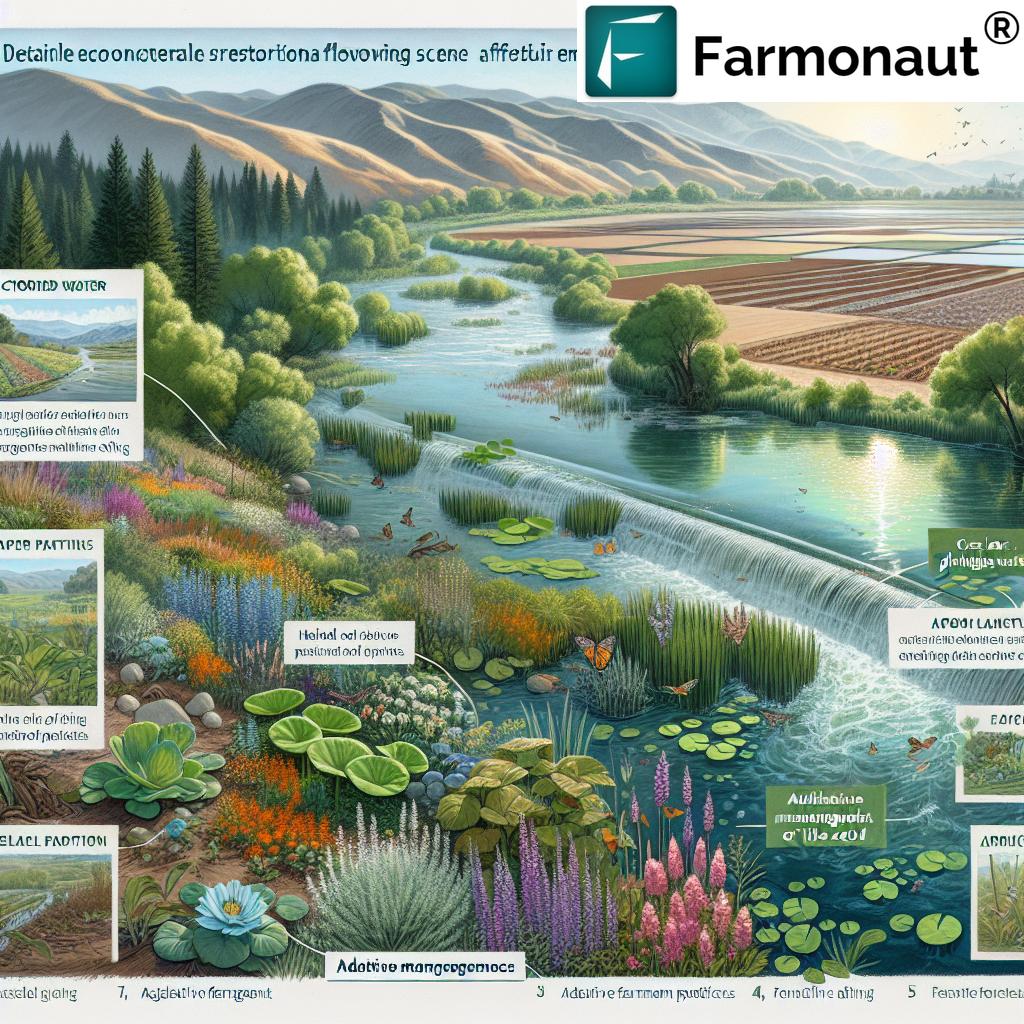California Dam Removal: 7 Key Impacts on Water & Farming
Introduction
California’s diverse landscape has long been shaped by the construction of dams and reservoirs, providing critical benefits such as water storage, hydroelectric power generation, flood control, and support for agricultural expansion. Today, the reality is evolving: many of these structures have outlived their original functions and, in some cases, are contributing to environmental degradation and altered river flows.
As the movement for dam removal in California accelerates, the resulting changes raise essential questions about water quality, agriculture and water availability, local ecosystem health, and the sustainable management of our natural resources. Understanding both the opportunities and the challenges in ecological restoration is crucial for ensuring the resilience and prosperity of California’s farming, forestry, and rural communities.
Focus Keyword: Dam removal in California
Historical Context and Rationale for Dam Removal in California
Across California, the 19th and 20th centuries saw the rapid construction of dams designed to store water, generate power, and control seasonal flooding. These structures were vital to supporting agricultural expansion in regions such as the Central Valley and enabled countless recreational activities along once wild river systems.
However, many of these dams now face significant issues:
- Sediment Accumulation: Over decades, dams have trapped large volumes of sediments, reducing their water storage capacity and impacting downstream riverbeds and quality.
- Structural Deterioration: Aging construction and maintenance challenges have left some dams unsafe or uneconomic to operate.
- Ecological Degradation: Dams disrupt natural river flows, block fish migrations, change temperature and nutrient cycling, and fragment habitats, threatening biodiversity.
Supporters of dam removal in California emphasize the restoration of ecosystem functions, improved water quality, and revival of iconic species like salmon and steelhead trout. The environmental impact of dam removal touches not just nature but agriculture, rural communities, and long-term water management. Exploring these impacts in depth is vital as the state weighs next steps for its aging water infrastructure.
7 Key Impacts of Dam Removal on Water & Farming
The effects of dam removal on farming, water quality, and river ecosystem restoration are multifaceted. While each river and watershed is unique, seven core impact areas consistently emerge as most consequential for California’s future environmental and agricultural wellbeing.
1. Water Quality Enhancement
Dams fundamentally change the transport and cycling of sediment, nutrients, and pollutants through river systems. Over years, pollutants—ranging from agricultural runoff to industrial byproducts—can build up behind dams, creating localized water degradation and unhealthy reservoirs. When removing dams:
- Restoring natural sediment flows: Sediment trapped behind dams is often high in nutrients, which can improve soil fertility and downstream riparian zones, supporting healthier agriculture and forestry landscapes.
- Reducing pollutant buildup: Free-flowing rivers reduce the stagnation that leads to harmful algal blooms and improve overall water quality downstream for farming and human activities.
- Short-term challenges: Initial sediment management in rivers is crucial to preventing excessive turbidity, which could temporarily disrupt irrigation systems or affect aquatic life.
By improving water quality downstream, dam removal can lower the reliance on cleanup or water treatment, enhancing the sustainability of California’s agriculture and supporting both urban and rural communities.
2. River Ecosystem & Biodiversity Restoration
River ecosystem restoration is a central goal of dam removal initiatives. Many California rivers once supported rich networks of riparian forests, wetlands, and dynamic habitats for fish, birds, and mammals. Dams disrupted these by:
- Altering riparian zones: Changed flows led to degradation of plant communities vital for nutrient cycling and soil stability.
- Impeding fish migration: Native species (salmon, steelhead trout, lamprey) lost access to traditional spawning habitats.
- Reducing biodiversity: The fragmentation of ecosystems reduced genetic diversity and made restoration more difficult.
Dam removal offers the chance to restore these natural functions:
- Reviving native species: Improved passage for migratory fish and aquatic organisms supports species recovery—including iconic salmon runs vital to cultural and economic life.
- Enhancing ecosystem services: Healthy wetlands and riparian buffers improve soil fertility, reduce erosion, and contribute to air and water purification. These areas support forestry resources and agricultural production.
3. Agricultural Irrigation & Water Availability
A major concern for farming and agriculture is how water availability will change as dams are removed. In many California regions, dams store spring snowmelt and rainfall, releasing it for irrigation and urban supply during dry summer months. With dam removal in California:
- Changed water supply timing: Restored rivers return to natural flows, which may not align with crop planting and harvest cycles, potentially causing challenges in management.
- Pressure on alternative sources: Groundwater wells, aquifers, and groundwater-based irrigation systems may face increased demand, potentially causing future depletion if not carefully managed.
- Incentive for efficiency: Dam removal can drive investment in water-saving practices and technology, such as drip irrigation and advanced scheduling—a significant benefit for sustainable water management strategies.
Farmonaut’s large-scale farm management tools empower farm owners and agribusinesses to monitor water usage, track crop health, and optimize irrigation in real time, supporting adaptive water management during and after dam removal projects.
4. Fish Migration and Native Species Recovery
One of the most visible environmental impacts of dam removal is on native fish populations. Dams act as barriers to upstream movement, preventing spawning and reducing natural population resilience.
- Restoring natural connectivity: Free-flowing rivers let salmon, steelhead trout, and other species return to historic breeding grounds, resulting in increased populations and genetic diversity.
- Cultural and economic benefits: Salmon are not only ecologically vital but are also central to tribal traditions and local economies.
- Broader ecosystem effects: Improved fish runs benefit birds, mammals, and aquatic insects, driving ecosystem health.
However, the process requires careful sediment management in rivers during removal to avoid smothering critical breeding grounds or causing excessive turbidity that harms eggs and young fish.
Learn more about traceability solutions for sustainable supply chains and how Farmonaut’s blockchain technology can enhance the transparency and trust in food production as we balance fishing, farming, and environmental restoration goals.
5. Changes in Flood Risk Management
Dams are central to flood control in many Californian watersheds, especially those prone to intense winter precipitation or rapid spring snowmelt. Their removal alters how floodwaters travel and recede:
- Reactivating floodplains: Natural flooding rejuvenates riparian soils and wetlands while rebuilding natural sediment patterns. This benefits forestry, soil fertility, and ecosystem services long interrupted by artificial flow constraints.
- New risks to communities: The absence of controlled releases may increase localized flood risks for towns, croplands, and agricultural infrastructure adjacent to rivers.
- Engineering and management adaptation: Upgrades to levees, restoration of upstream wetlands, and adoption of adaptive management strategies can address these risks while allowing environmental benefits to flourish.
With river flows restored, communities must embrace new flood response measures and landscape planning approaches to safeguard agricultural and residential zones.
Farmonaut’s fleet management system offers agricultural businesses real-time insights for rapid deployment and coordination of machinery and emergency response vehicles during flood events, reducing potential crop losses and supporting safe farm operations.
6. Groundwater Recharge and Riparian Zone Health
The groundwater resources beneath California’s major valleys support both urban and agricultural water use. Dams alter natural recharge patterns:
- Decreased infiltration: Dams often prevent floodwaters from spreading across floodplains and riparian zones, reducing natural recharge of aquifers.
- Dam removal benefits: Restored overbank flows can substantially improve groundwater recharge, raising local water tables and enhancing soil moisture for farming, forestry operations, and rural wells.
- Riparian zone recovery: Healthier riparian ecosystems further reduce erosion, foster biodiversity, and support more resilient agricultural systems.
Balancing surface water availability and groundwater recharge requires coordinated management, particularly as climate change intensifies drought and flood cycles across the region.
Explore Farmonaut’s carbon footprinting feature, which helps monitor environmental changes following restoration activities, supporting sustainable forestry and agriculture goals.
7. Sustainable Water Management and Adaptive Strategies
The move toward sustainable water management strategies is at the heart of California’s dam removal efforts. Success depends not only on physical interventions but also on how communities, farm owners, foresters, and policymakers respond and adapt. Key practices include:
- Advanced irrigation management: Utilizing satellite-based monitoring and AI-driven advisory systems, such as those from Farmonaut, enables precise water use and supports healthy crops even when supply patterns shift.
- Adaptive crop selection: Choosing less water-intensive crops and adjusting planting schedules in response to changing river flows can improve economic resilience and resource conservation.
- Strengthening resource management: Integrating real-time data on weather, soil moisture, and crop health empowers farmers and forestry managers to maximize yield with minimal inputs.
- Community-led solutions: Establishing clear protocols for flood response, groundwater monitoring, and riverbank stabilization further supports a smooth transition to post-dam landscapes.
Robust resource management and multi-stakeholder participation form the foundation for a thriving, sustainable California agricultural sector in the future.
For developers and agri-innovators: Integrate Farmonaut’s real-time satellite data using our satellite & weather API or explore detailed guides at our API Developer Docs to build custom management tools for adaptive, sustainable agriculture and restoration.
Table: Key Impacts of California Dam Removal on Water & Farming
| Impact Area | Estimated Change | Main Challenges | Environmental Benefits | Potential Solutions |
|---|---|---|---|---|
| Water Quality | Increase in clarity, up to 60% reduction in downstream pollutant retention after initial transition | Temporary turbidity increase; sediment and pollutant flush; management of nutrient surges | Cleaner river water, reduced algal blooms, better habitat for aquatic life | Sediment management plans; phased dam removal; advanced monitoring systems |
| River Ecosystem Health | Increase in habitat connectivity; up to 90% restoration of natural sediment flow | Invasive species spread; initial disturbance to riparian zones | Enhanced biodiversity, wetland recovery, improved nutrient cycling | Riparian replanting; invasive species management; ecosystem-based restoration |
| Agricultural Irrigation | Potential decrease in regulated water storage; more variable seasonal flows | Unpredictable water supply; synchronization with crop cycles | Stimulates adoption of water-efficient technologies, promotes water-smart crops | Drip irrigation; water reuse; satellite-based irrigation management; flexible cropping strategies |
| Fish Migration | Increase in spawning success; potential 2-4x boost in salmon/steelhead returns | Short-term impacts from sediment release; fish passage at other barriers | Stronger fish populations, healthier food webs | Fish monitoring and support; careful removal timing and methods; fishway restoration |
| Flood Risk | Localized increase in natural flood events; regionally variable outcomes | Floodplain management; protecting downstream communities and farmlands | Restored soils, recharge of wetlands, natural flood mitigation | Levee upgrades; floodplain zoning; community preparedness plans |
| Groundwater Recharge | Increase in aquifer levels (15-40% depending on geography and soil type) | Need for monitoring and adaptive pumping; saline intrusion in some areas | Deeper, more resilient water reserves; sustained baseflow for rivers | Groundwater monitoring; recharge basin development; sustainable pumping policies |
| Sustainable Water Management | Enhanced need for adaptive, tech-driven management | Stakeholder coordination; balancing economic and environmental goals | Sustainable yields, healthier ecosystems, climate resilience | Data-driven planning; financial incentives for conservation; participatory management |
Challenges and Solutions in Ecological Restoration
The journey toward comprehensive river ecosystem restoration in California is complex, presenting a number of intertwined challenges and opportunities:
Challenge: Short-Term Water Quality Impacts
Sudden releases of sediment and pollutants can disrupt both aquatic life and agricultural irrigation systems downstream. Strategic, phased removal and real-time water quality monitoring are essential to minimize shocks.
Challenge: Agricultural Water Reliability
Farmers reliant on dam-regulated water face uncertainty in availability. Solutions include investing in high-efficiency irrigation technologies, optimizing release timing, and leveraging predictive analytics for adaptive management.
- Example Solution: Farmonaut’s Farm Management Platform delivers remote crop health and water stress analytics, allowing growers to react proactively to changing river flows.
Challenge: Sediment Redistribution and Infrastructure Risk
Uncontrolled sediment flow may block irrigation canals, lower reservoir life of downstream dams, or threaten bridges and levees. Comprehensive sediment management in rivers—including gradual drawdown or engineered sediment bypass—can reduce risks while maximizing long-term ecosystem gains.
Challenge: Socioeconomic and Community Adaptation
Transitioning from dam-supported activities (such as recreational boating, irrigated farming, and hydroelectric generation) calls for coordinated economic adaptation and investment:
- Develop alternative recreation resources (e.g., white-water rafting, wildlife tourism)
- Support workforce transition for hydroelectric and dam management professionals
Challenge: Long-Term Monitoring and Maintenance
Ecosystem restoration doesn’t end at dam removal—ongoing monitoring and rapid response to invasive species, erosion, and changing resource conditions are essential for lasting success. Satellite and drone imagery, along with on-the-ground citizen science, are crucial tools in ensuring sustainable management.
How Farmonaut Supports Sustainable Agriculture During Dam Removal
At Farmonaut, our mission is to empower farmers and agricultural stakeholders with cutting-edge technology for resource-efficient, sustainable agriculture—especially as California transitions through projects like dam removal and river restoration. Our platform offers critical tools for adapting to new water quality and resource management challenges:
- Satellite-Based Crop Health Monitoring: We enable real-time detection of soil moisture, crop stress, and vegetation health, allowing users to quickly respond to changes caused by shifting river flows or sediment levels.
- Jeevn AI Advisory System: Our AI-driven insights guide farmers through unpredictable irrigation patterns, offer weather forecasts, and recommend optimal practices for sustainable water management strategies.
- Blockchain-Based Product Traceability: Enhance transparency from farm to table and align with consumer demand for verifiable, sustainable food production, especially as environmental factors shift.
- Fleet and Resource Management: Coordinate machinery and logistics to efficiently manage flood risks, field maintenance, or infrastructure repairs during major environmental transitions.
- Carbon Footprinting: Monitor and reduce greenhouse gas emissions and track the ecological benefits of restoration activities, providing valuable reporting for regulatory compliance and sustainability certification.
Our data-driven, scalable solutions are designed for farms of any size and nature, including those impacted by dam removal in California. From precision farming to environmental stewardship, Farmonaut stands at the frontier of agricultural and environmental technology—making adaptation affordable and actionable for all.
Explore Farmonaut’s Flexible Subscription Options
Frequently Asked Questions (FAQ)
Conclusion: Towards a Sustainable, Resilient California
The acceleration of dam removal in California marks a pivotal step toward river ecosystem restoration, healthier landscapes, and a future where environmental goals are balanced with agriculture and community needs. While challenges in ecological restoration—from short-term water disruptions to economic adaptations—are significant, the potential benefits for water quality, fish migration, biodiversity, and long-term climate resilience are profound.
Navigating this transition requires innovative tools, community collaboration, and adaptive management—areas where leading-edge agricultural platforms like Farmonaut shine. By integrating precision agriculture, blockchain transparency, and real-time resource management, California’s farming and forestry sectors can thrive alongside revitalized rivers and restored ecosystems.
The success of dam removal in California will be measured by our ability to harmonize economic opportunity, agricultural productivity, and environmental stewardship. With optimism and smart strategies, we can build a more resilient food system and a healthier environment—for generations to come.















